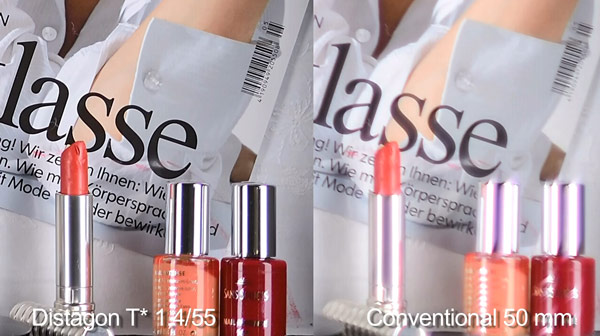
-
Should we even ask how much this lens costs...
-
Should we even ask how much this lens costs...
You could try. Around 3000 EUR.
-
Conventional 50mm = could be anything. Could be a conventional 50mm magnifying glass.
...until we see real pics shot side by side at pixels, this is fairy dust.
-
Annoying video... sort of "you are idiots and I will tell you how it is". From the marketing it seems like they are targeting the hobbyist photographers (people who do not necessarily know very much but want what is good).
By the way.. I think I´ll settle for 60mm c/y macro instead. Speed is overrated.
-
As much as I like Zeiss glass, this is ridiculous! I wouldn't touch any lens as bad as the "conventional" one shown here.
-
Many F1.4 lenses wide open in 1:1 crop look like "conventional" lens shown here.
-
Really would buy it!! And a 28mm, a 90mm !!!
-
When the 1.4/55 focal length comes onto the market at the end of 2013 as the first member of the new high-end family of SLR lenses, it will not only introduce a new lens with uncompromising image quality. The lens’s new prize-winning product design will also be a talking point. “ZEISS lenses are known for their technical precision, excellent image performance and ergonomics. That will always be the case because we know photographers’ needs and user circumstances. But our new lenses should also fulfill the highest aesthetic expectations of our customers to become design objects in their own right,” explains Martin Dominicus, Head of Marketing in the Carl Zeiss Camera Lens Division
About design of this lens - http://blogs.zeiss.com/photo/en/?p=3427
-
This lens is also made for Nikon mount. The IQ at f/1.4 looks fantastic on the D800 but DOF is really very shallow then, shallower than Nokton at f/0.95 on the GHx cameras has.
Look here: http://www.cameraegg.org/zeiss-55mm-f1-4-distagon-t-lens-the-best-fast-50mm-ever/
12 glass elements inside! Impressive for a f/1.4 lens. This is a gem, and gems like this one are just expensive. It is OK from Zeiss to request high price for such a lens, who wouldn't?
-
It seems like they could make two hours long film and write an epic about this lens :-)
The project had been discussed internally at ZEISS for a long time. The first concepts were already discussed in 2008, but it was not until 2010 that things became concrete. Back then it was clear to the experts at ZEISS that the image sensors in the new generations of cameras would make such a big leap forward that there would already be a need for corresponding high-performance lenses in the medium term. In 2012, the Nikon D800 came on the market, equipped with a full-frame sensor with 36 megapixels. This was the highest resolution of any sensor in a full-frame camera to date. ZEISS wanted to offer photographers a range of high-end SLR lenses that would enable them to use the full potential of such cameras. Such a combination would achieve performance values that would be comparable to those of medium-format systems.
To learn more about customers’ wishes, ZEISS worked with a lot of photographers. The product managers defined the target groups to be professional photographers and very ambitious hobby photographers. In interviews with selected customers, the product managers asked about areas and situations in which conscientious, manual picture-taking plays out its strengths. After analyzing the answers, it was decided to focus on portraits, landscapes and still lifes. “We knew that hardly anyone would buy the complete family, but we expect that demanding customers, such as photographers who work in advertising, would decide for at least one of the new lenses,” says Balle.
Thanks to the ZEISS team’s good sense for the market, an attractive solution had been found which customers liked from the start. An additional challenge was the continuously growing physical size of the first member of the new family, which was inevitable for reasons of physics: the large aperture of f/ 1,4 and other optical characteristics require a rather complex optical system with a relatively large amount of glass. When used with a DSLR camera with a high-resolution sensor, the system was considered by customers to be nevertheless balanced and coherent, despite its size and weight.
“When the 1,4/55 comes onto the market at the end of 2013 as the first in this family of lenses, it will be one of the best lenses in the world,” summarizes Casenave. “There will be nothing of comparable quality, and that not only applies to this specific focal length range. With this product ZEISS has truly opened up a new dimension of digital full-frame photography.”
Howdy, Stranger!
It looks like you're new here. If you want to get involved, click one of these buttons!
Categories
- Topics List23,998
- Blog5,725
- General and News1,360
- Hacks and Patches1,153
- ↳ Top Settings33
- ↳ Beginners256
- ↳ Archives402
- ↳ Hacks News and Development56
- Cameras2,367
- ↳ Panasonic995
- ↳ Canon118
- ↳ Sony156
- ↳ Nikon96
- ↳ Pentax and Samsung70
- ↳ Olympus and Fujifilm101
- ↳ Compacts and Camcorders300
- ↳ Smartphones for video97
- ↳ Pro Video Cameras191
- ↳ BlackMagic and other raw cameras116
- Skill1,960
- ↳ Business and distribution66
- ↳ Preparation, scripts and legal38
- ↳ Art149
- ↳ Import, Convert, Exporting291
- ↳ Editors191
- ↳ Effects and stunts115
- ↳ Color grading197
- ↳ Sound and Music280
- ↳ Lighting96
- ↳ Software and storage tips266
- Gear5,420
- ↳ Filters, Adapters, Matte boxes344
- ↳ Lenses1,582
- ↳ Follow focus and gears93
- ↳ Sound499
- ↳ Lighting gear314
- ↳ Camera movement230
- ↳ Gimbals and copters302
- ↳ Rigs and related stuff273
- ↳ Power solutions83
- ↳ Monitors and viewfinders340
- ↳ Tripods and fluid heads139
- ↳ Storage286
- ↳ Computers and studio gear560
- ↳ VR and 3D248
- Showcase1,859
- Marketplace2,834
- Offtopic1,320







